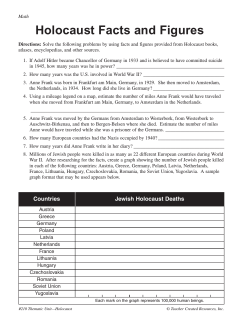
Environmental Benefit from Increasing Active – A Case Study in Adelaide Transportation
South Australia’s Environment Protection Authority Environmental Benefit from Increasing Active Transportation – A Case Study in Adelaide Dr Pushan Shah Senior Scientific Officer, Air Modelling Environment Protection Authority, Adelaide 11th April 2014 Concept of Airshed Source: http://myecoproject.org/get-involved/pollution/causes-and-effects-of-air-pollution/ Ambient Air Quality NEPM National Environment Protection Measure Criteria Pollutants • Carbon monoxide • Nitrogen dioxide • Photochemical Oxidants (as Ozone) • Sulfur dioxide • Lead • Particles (PM10 & PM2.5) Australian Policy Instruments In Australia “criteria” Pollutants are defined by National Environment Protection Measures (NEPMs) established by the National Environment Protection Council (NEPC) National Air Quality Standards (Air NEPM 2003) Pollutant Averaging period Maximum concentration Goal/ Max no. exceedences Carbon monoxide 8 hours 9.0 ppm 1 day a year Nitrogen dioxide 1 hour 1 year 0.12 ppm 0.03 ppm 1 day a year none Photochemical oxidants (as ozone) 1 hour 4 hours 0.10 ppm 0.08 ppm 1 day a year 1 day a year Sulfur dioxide 1 hour 1 day 1 year 0.20 ppm 0.08 ppm 0.02 ppm 1 day a year 1 day a year none Lead 1 year 0.50 μg/m3 none Particles as PM10 1 day 50 μg/m3 5 days a year Particles as PM2.5 1 day 1 year 25 μg/m3 8 μg/m3 gather sufficient data to inform standards process Drivers for Air Quality (AQ) • Emission sources and their strengths – Point/Area Sources -e.g. industry stacks, landfills – Motor vehicles (in urban area) – Domestic heating e.g. wood heaters – Other diffuse sources • Geographical features of the region – Surface roughness, presence/absence of hills and/or aquatic body • Meteorology – Wind Speed and Direction – Temperature and Relative Humidity – Rainfall and cloud cover Road Network in South Australia National Highway = 2750 Km Urban Arterial = 920 Km Rural Arterial = 8600 Km Data obtained from Various Government Departments Ambient Particles Size Matters! 10 Population exposure in Adelaide •PM10 concentrations are associated with increases in morbidity in Adelaide •Increase in daily hospitalisations per 10 μg/m3 increase in daily PM2.5 • Respiratory : 3% (Winter) • Cardiovascular: • 4.5% (Winter) • 2.7% (All season) Hansen A, et al, Particulate air pollution and cardiorespiratory hospital admissions in a temperate Australian city: A case-crossover analysis, Science of the Total Environment (2012), doi:10.1016/j.scitotenv.2011.09.027 Population exposure in Adelaide •Statistical Analysis •GIS based linkage of spirometry data with density of cars per 24 hour derived from motor vehicle database. •Significant exposure response relationships in COPD sufferers Nitschke M, Li Q et al, 2012 Traffic Density: Effect on Chronic Obstructive Pulmonary Disease, Manuscript under preparation The Circle of Air Quality Management Air Quality Monitoring Population Exposure Air Quality Modelling Emissions Inventory or Database Air Quality Monitoring in Adelaide AIR QUALITY MODELLING Macro & Micro scale circulation Wind Speed / Direction, Temperature, Humidity, uncontrolled Mixing Height, controlled Soil type, topography, Air Quality terrain height and buildings EMISSION RATE Source(s) g/sec; kg/hr or tonnes/year EMISSIONS INVENTORY CONCENTRATION μg/m3; ppm Motor Vehicle Emissions Inventory Pollutants CO, PM, NOx, SO2, hydrocarbons etc Activity Number of Vehicles Distance Travelled Hot Emissions Tyre wear, brake wear, road dust etc Technology/Emission Standard Mean Travelling Speed (km/h) Cold Emissions Technology/Emission standard Mean Travelling Speed (km/h) Ambient Temperature Mean Trip Distance MV Emissions Inventory Database Current Focus - Air Science in South Australia • Continuous monitoring of PM2.5 in mixed used region and developing regions • Continuous monitoring of other pollutants such as benzene and toluene • Development of an updated emissions inventory database • Understanding population exposure • Airshed capacity analysis of developing metropolitan region What is alternative transport? • Modes of transport, and systems of transport planning, which are consistent with wider concerns of sustainability. Finding from literature • 2009 London Study: Shift from 10 to 30 minutes/day of walking and bicycling: 10-19% Cardiovascular Disease (3140-6820 deaths) 12-13% Breast Cancer (200-210 deaths) 7-8% Dementia (200-240 deaths) 15% Diabetes 19% of traffic injuries 2012 Barcelona Study: 50% of short trips were replaced by bike, 22% by bus/tram and 28% are by metro/train inside Barcelona: • 10 fewer deaths /year due to air pollution reduction 44 fewer deaths /year due to increased physical activity 0.02 fewer deaths /year due to road traffic fatality *Woodcock J, Edwards P, Tonne C, Armstrong BG, Ashiru O, Banister D, et al. Public health benefits of strategies to reduce greenhouse-gas emissions: urban land transport. The Lancet 2009;374:1930-1943 *Rojas-Rueda, D, de Nazelle, A, Teixido, OandNieuwenhuijsen, MJ 2012, 'Replacing car trips by increasing bike and public transport in the greater Barcelona metropolitan area: A health impact assessment study', Environment International, vol. 49, Nov 15, pp. 100-109. 23 Method-Air pollution model Environmental Protection Authority Motor Vehicle Emission Inventory • Annual daily VKT • Annual daily traffic emissions (PM2.5) Air Pollution Model • population-weighted annual mean Graphical User concentration of PM2.5 Interface (TAPM) The Air Pollution Model Method-Scenario Construction Scenarios and annual average daily vehicle travelled kilometer (VKT) Millions Passenger vehicle Commercial vehicle 40 35 30 25 20 15 10 5 0 T ng ng PT PT 30 A i i l l 0 010 o o s c c 2 t t 2 d y y e lin BUA ing t o c ing to c shifting shifting war e o s T a B hif hif s s 20% 30% % % 5 10 Method-Scenario Construction Scenarios and annual average daily PM2.5 emission (tons) Passenger vehicle Commercial vehicle 1.20 1.00 0.80 0.60 0.40 0.20 0.00 PT PT AT ling ling 030 010 o o s c c 2 t t 2 d y y e r A c c lin BU to wa to ting shifting e f o i s g g T a h n n i i s B hif hif s s 0% 0% 2 3 % % 5 0 1 *PT: Public transport AT: Alternative transport Results-PM2.5 due to traffic by location BAU 2030 Towards Alternative Transport Scenario Results Air Quality Benefits from Alternative Transport VKT Reduction PM2.5 Reduction(μg/m3) 20% 30% 40% 0.2 0.3 0.4 Estimated Annual Change in Burden of Disease Premature deaths 6 11 13 DALYs 52 98 118 DALY = disability adjusted life years Results-summary of finding • 2013 Adelaide Study: 10% passenger VKT would be replaced by cycling, 30% by public transport in metropolitan area: Cardiovascular Disease (9 deaths) Respiratory (2 deaths) Lung cancer (2 deaths) Colon cancer (25 deaths) Breast cancer (11deaths) IHD (197deaths) Stroke (64 deaths) Type 2 diabetes (9 deaths) Falls (16 deaths) Depression (20 deaths) 31 Results-summary of finding Estimated Annual Change in Burden of Disease (DALYs) from PM2.5 Exposure and Physical Activity Compared with BAU in Adelaide, South Australia Increased Public Transport Increased Cycling 5% shifting 10% shifting 20% shifting 30% shifting Towards Alternative Transport 40% shifting Cardiovascular 22 22 29 55 66 Respiratory 8 8 11 21 25 Lung cancer 9 9 12 22 27 Colon cancer 154 318 0 0 318 Breast cancer 98 201 0 0 201 IHD 835 1746 0 0 1746 Stroke 258 531 0 0 531 Type 2 diabetes 320 660 0 0 660 Falls 94 210 0 0 210 Depression 303 622 0 0 622 Total 2062 4288 52 98 4406 Summary A travel mode shift towards alternative transport has the potential to benefit air quality and reduce the population health impact from particle matter in an Australian setting. A small shift from car travel distance to cycling would also lead to considerable health co-benefits of increasing physical activity. Slide Number 33 Limitations Only use PM2.5 as indicators of air pollution exposure Difference between emission and exposure Only projected the health co-benefits occurring in one “accounting year” Uncertainty of key assumptions Age issues Did not consider the road traffic fatalities because lack of baseline date TAPM limitations 34 Where to from here? • Further work required to update emissions inventory • Validation of models (remember „the circle of air quality management‟) • Community risks and their long term management? role of traffic emissions and industrial emissions in Urban and mixed used area? proximity to major roads as a risk factor? effect of other sources (eg.wood heaters) on air quality in Adelaide and regional centres? • Opportunities to collaborate as „Special Interest Group‟ Acknowledgments Co-authors : Ting Xia, Ying Zhang, Monika Nitschke, Shona Crabb Kelvyn Steer and Rob Mitchell, Environment Protection Authority Government of South Australia Korea Public Health Association Method- Health impact assessment Comparative Risk Assessment estimate the burden of disease (DALYs) attributable to changes in exposures between baseline and each scenario AF: attributable fractions R: relative risk P: the proportion of the population exposed Q: counterfactual distribution of exposure Method-Physical activity of travellers Physical activity level: Sedentary, Insufficiently active and Sufficiently active In Increased cycling scenarios, shifted VKT was divided in to short-distance (< 5km), medium-distance (5-10km) and longdistance (10-15km). one level up <5km 50% one level up 50% two levels up two levels up 5-7.5km 7.5-10km Cycling distance was then converted into number of cyclists per thousand people (evenly spread to each age-sex group). Slide Number 38
© Copyright 2025





















